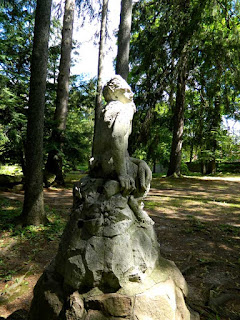 |
| 12th Century Bronze Buddha |
And except for the waterlilies that appear in the garden's ponds during summer, this garden features no flowers. But that does not diminish its beauty. Much to the contrary, it enhances it as it allows the visitor to quietly take in the natural surroundings simply accented by stone lanterns, the Tea House, and of course, our 12th century bronze Japanese Buddha. If you talk to the guests about the garden, this larger than life-sized statue is the one piece of the garden that is almost always mentioned for the statue has an amazing and palpable serene presence.
The statue sits in the corner of the garden nearest to the Roman Bath -- always peaceful and always quiet. It is a peace that is infectious for most. But there is a story about this statue rumored to have taken place after the bombing of Pearl Harbor. Supposedly two local men were going to destroy the statue with axes as some sort of punitive act for the bombing. And sure enough, there are two cuts in the chest of the statue that had to be created with a bladed instrument and some degree of force. But only two cuts.
Is the story real? I don't truly know but I've heard it from a couple of sources and it is at least part of the Sonnenberg lore some like to share. If it is true, why did the men stop at one stroke each? Did that peaceful gaze look down into their hearts and cool their thirst for vengeance? Perhaps.
 |
| Two cuts are visible on the statue's chest |
 |
| Offerings often appear in the statue's hands |




























